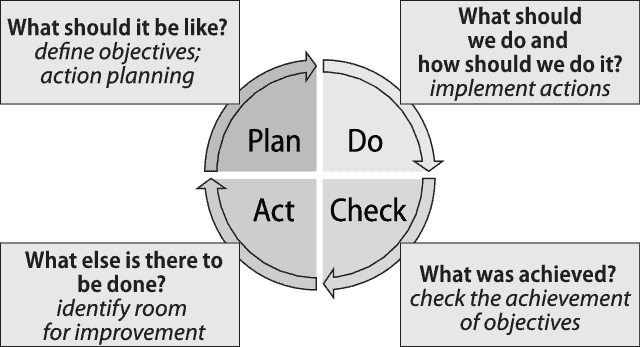Origin of Kaizen
Looking at Kaizen under a bigger lens
When looking at this conceptual philosophy under a magnifying lens, you can explore what it actually means. This concept revolves around how the slightest change can have a rippling bullwhip effect on the main functions of a company, such as the work ethics, the delivery standards, quality controls, efficient equipment usage, and cutting off waste and more. Secondly, this concept explains the effect a single individual can have on the whole organisational growth so when inspiring the corporate efforts to be better, it is crucial that the entirety of all operational and administrative stakeholders are motivated in exploring viable business solutions and potential professional, skilful improvement. Therefore, Kaizen is sheerly boosted up by collaborativeness! It fuels up many concepts and business functions, such as the Plan-Do-Check-Act cycle and JIT strategy, that are inclusive in Lean Manufacturing proposals. So to understand Kaizen in one sentence:
“Kaizen shows how minute, advantageous changes can eventually result in major improvements; it believes that nothing is status quo since constant adaptation trumps organisational betterment.”
The 3 Pillars and 10 principles of Kaizen
Kaizen is a concept that can be utilised by different organisational tools and strategies, but it lies on three basic pillars which strengthen the Kaizen process at every point. They are:
Gemba
Gemba (Workplace) is a pillar that encompasses the efforts that must be made by the company to ensure that you have the right tools, the right team to work without any clutter.
Muda
Muda (Waste), focuses on the elimination of corporate waste that hinders the smooth flow of operations. Some examples are overestimation of stock requirements, unconfigured workstation layouts, unnecessary utility expenses, unscheduled usage of machinery, longer idle time, product defects and more.
Standardised Change
This pillar addresses the iterative sprints to drive towards positive changes proactively. For example, you can employ the Plan-Do-Check-Act cycle to mould the business functions to adapt according to the most recent changes and achieve the Kaizen-worthy standards.
Also, there are ten principles a company must be familiar with if they are to attain Kaizen-standard changes in their company. The ten principles stated below are the core elements that prepare the company for the Kaizen mindset.
- Never rely on assumptions.
- Always act fast when solving problems.
- Never stagnate in the status quo.
- Do not believe you are at a constant state of perfectionism; you can forever change and improve.
- Investigate for solutions when you detect mistakes.
- Provide an environment that encourages everyone to contribute to finding solutions.
- Do not resolve the apparent issue but ask yourself “why?” five times to capture the problem’s root cause.
- Extract opinions, ideas and information from multiple people.
- Creatively think to find cost-efficient, minuscule improvements.
- Never stop searching for improvement.
Learning about Kaizen as a 7-step cycle
Implementing Kaizen in your business culture can be attained by following seven iterative steps. Following these steps -continuously- will help your team make a round-check of how resilient your company operations are to unanticipated changes. The seven steps briefly explained below will guide you to attain pure improvement through change.
- The Continual Involvement of Employees
For optimal deployment of Kaizen practices in an organisation, there must be cutting-edge teamwork and improved morale to dedicate and actively participate in detecting issues and discrepancies that are slowing down the business’ growth. It is vital to initiate the cycle, assuming the broader the scope of problem-finding involvement, the faster you will be able to detect your organisation’s limitations. - Pinpointing a list of organisational limitation
Once you have many active participants, you can create a list of limitations in your organisation. In this stage, these problems undergo an analytical process to identify why they were spurred in the first place. Once you collaboratively figure out the root causes of these problems you can move into the next stage. - Pool-in ideas from everyone; filter-out the best
Encourage everyone to contribute to creative solutions. This step is important because it does not only find solutions to initiate transformation; it also signifies that you value the opinions of your employees, making them satisfied with their workplace cultures. Filter out the best solutions for the problem during this step. - Testing the solution
The winning solution must be picked out of the alternative solution and implemented while letting everyone be a part of the rollout. The shared responsibility of everyone will create a sense of trust and collaborativeness when implementing the solution too. You can utilise pilot programs or any other method to test out the success rate of the solution. - Constant monitoring and analysis of results
The team must adopt various analytical tools to analyse the resulting change that was spurred by the solution implementation. You can check the progress of the change by specific plans that guide the team on how to cultivate satisfactory results through the solution. - Adopting Solution if adaptation is successful
If the results of the change are optimal, you can resolve by permanently employing the solution after contrasting the results of the old method and the newly changed method. If the new approach is more efficient, you can go ahead with your team to standardise its better practices by replacing the old methods. - Repeat the Kaizen Process for continual growth and adaptation
Since Kaizen believes that there is always room for continuous development and adaptation, the above steps must be repeated to find new solutions to new limitations of the organisation. Note that the cycle can be re-initiated at the 5th phase if the solution does not display fortunate results.
The PDCA Cycle- an alternate Kaizen Cycle
The Shewhart Cycle or the Plan-Do-Check-Act (PDCA) cycle is similar to the main Kaizen Cycle explained above. It outputs the 7-step Kaizen cycle’s net result- more like a condensed version of the latter- but it is prevalent in the enterprise context. The four steps of this cycle are explained below:
- Plan – Pre-map out the required improvements
- Do – Implement the necessary organisational changes
- Check – Check how successfully the new solution was implemented
- Act – Act according to the results and iterate on finding better adaptations

The 5Ss in Kaizen
The 5S framework must not be overlooked when understanding how the Kaizen system is accommodated into your business culture. This concept is a process that can be followed by an organisation to promote healthy, result-oriented work cultures that are compliant to certain rules and regulations. It simply humanises the workspace by enabling employee-friendly work environments with fewer wastages to utilise change to get better by every minute ultimately. As the name suggests, the 5S is an organisational framework that comprises five procedural stages that are labelled by 5 Japanese names starting from the letter ‘S’- the five components are explained below:
Seiri (Sort)
Explains the act of disposing of dispensable items or activities to organise the workplace to be simple as much as possible- fewer distractions the better- to enable agile operating capabilities. Having less complicated environments allows the employees to focus on their jobs inwardly boosting up their productivity levels.
Seiton (Set in Order)
Compartmentalising the workspace is the second consideration of this framework. Seiton addresses how you can categorise your workspace into stations or departments for better-operating capacities. Also, in a more particular level, the tools and equipment used in a single station must also be set accordingly, so that there will be no latency when completing multiple jobs. There are two Kaizen terms to explain the two ways of setting order. ‘Process Kaizen’ is the idea of changing individual work areas for better work efficiencies. Also, ‘Flow Kaizen’ focuses on the alterations made to improve the information and material flows that networks throughout the business.
Seiso (Shine)
This component addresses the clean and tidiness of the workplace since it directly impacts the workers and the clients’ minds. Working in hygienic and tidy places relieves the employees from stress and allows them to think out of the box and spark their creativeness since there won’t be any distractions or disoriented environments, making them mentally uncomfortable. Routined cleaning practices are the best way to ensure workplace cleanliness.
Seiketsu (Standardise)
Standardisation of acceptable work practices is mandatory too. This framework helps the organisation by reminding the team to habituate procedures that went well after implementation. Keeping good practices as a norm will naturalise good changes, giving the team more inspiration to find more straightforward, easier ways to meet corporate goals.
Shitsuke (Sustain)
The last but not least is the element that addresses sustenance in encouraging and implementing change in the workplace. Well-planned audits can help at this stage to get the bigger picture of actual organisational performance to find better ways to elevate the operative status of the organisation.
Is harnessing the Kaizen System advantageous for your company?
Like any strategy or ideation, Kaizen has ups and downs, but we wouldn’t be exaggerating if we deduce that the benefits outweigh the disadvantages of this organisational approach. Given below are two lists of the pros and cons of this inspirational approach.
Some of the benefits of Kaizen are:
- Encourages ceaseless focus on gradual organisational growth
- Lays the foundation for grassroots thinking instead of barricaded thinking
- Gradual Improvement results in disposing of wastages
- Lesser waste spurs better productivity in workplaces
- Trains the team to be result-oriented via continual change
- Reduces the time of process scrutiny
- Employees have a sense of purposefulness and value which will enrich their personal discipline
- Co-working capabilities will increase with collaborative problem solving
- Prioritising the client requirements will be increased
- The organisation will achieve cost and competitive advantage
- Employee empowerment via freedom of expression
- Optimises quality circles with awareness for improvement
- Normalises a culture of continuous growth
- It plays a serious commitment in the risk management context
- Teaches the team to proactively amend errors or boost substandard performances
- Inspires to find shortcuts in completing tasks
- Provides priceless experiences for your company and its stakeholders
Some of the disadvantages of Kaizen are:
- Short-lived excitement of change can be shallow and get abandoned before it naturalises in the company cultures.
- Companies that are habituated in closed communication will face obstacles in implementing a receptive environment to deploy the Kaizen System.
What Kaizen means in a corporate-scale
On a corporate scale, Kaizen plays dual roles; firstly, it can be regarded as a philosophy of toning up an organisational culture where all operative and managerial stakeholders collaboratively endeavour to improve the company, which lean companies would address as a natural way of thinking. Secondly, many companies would use the Kaizen system to level up specific business areas as an action plan technically. Either way, Kaizen is now too widespread for anyone to not hear about it. You can either practise Kaizen adaptation on a daily basis or host well-planned events. Many events are hosted by companies to streamline the adaptation of the Kaizen system, namely Kaizen Workshops, Kaizen burst, Kaizen blitz, rapid process workshops, focused improvement workshops, and more. The 5s framework, value stream mapping tools, and total productive maintenance systems empower these events since the Kaizen elements and principles directly impact them. Success stories of eventful Kaizen employment can be heard by reputed industrial winners such as Toyota, Ford, Lockheed Martin and Pixar Animation.
Now you know your Kaizen?
Kaizen is a term that you must tune your ears into if you believe that familiarising and exploiting change can bring your company better chances and opportunities to grow in efficiency and effectiveness. We hope that our article helped you in being Kaizen-minded for being aware that this result-generative approach is the shortest of all shortcuts to pave the way towards continuous alterations for your company always to be better than each passing minute.






